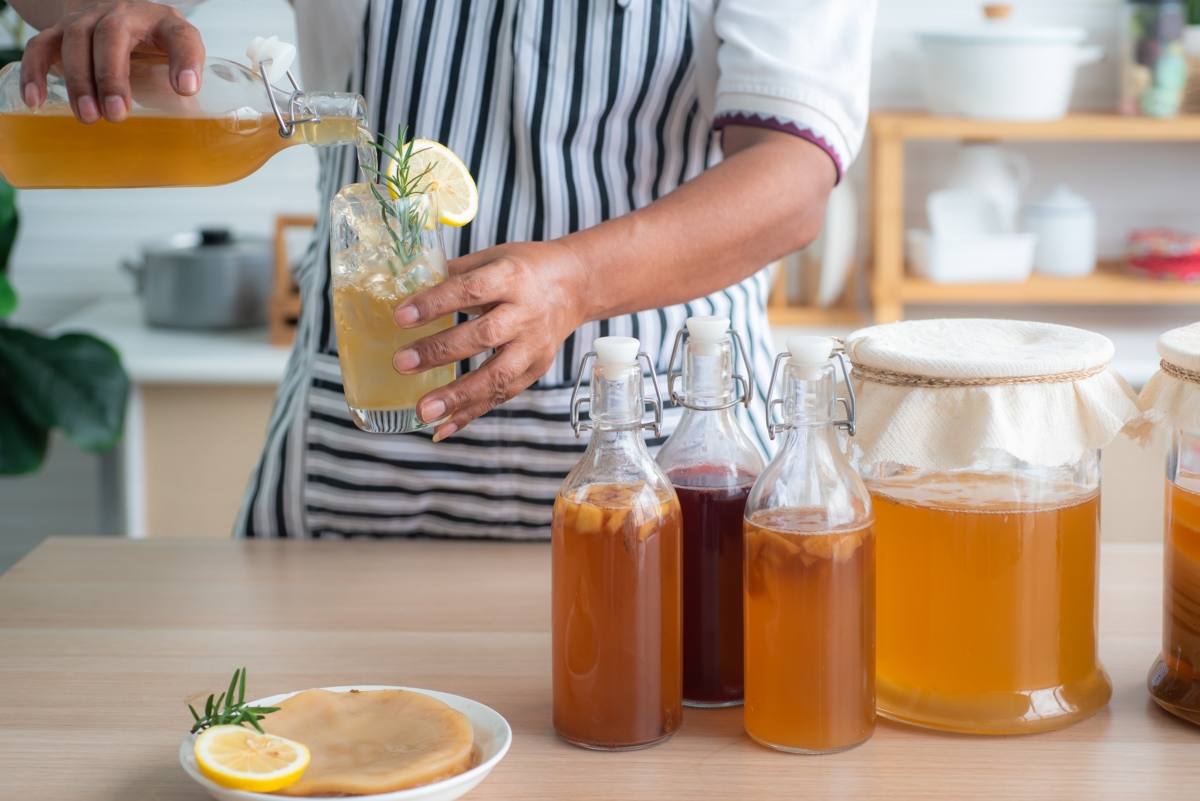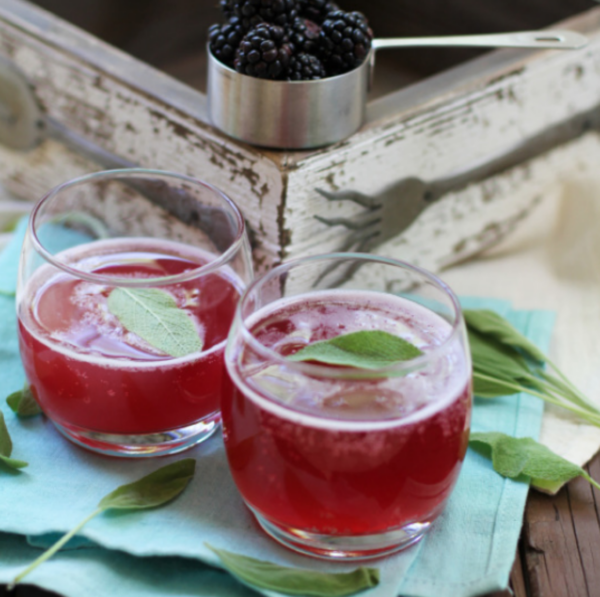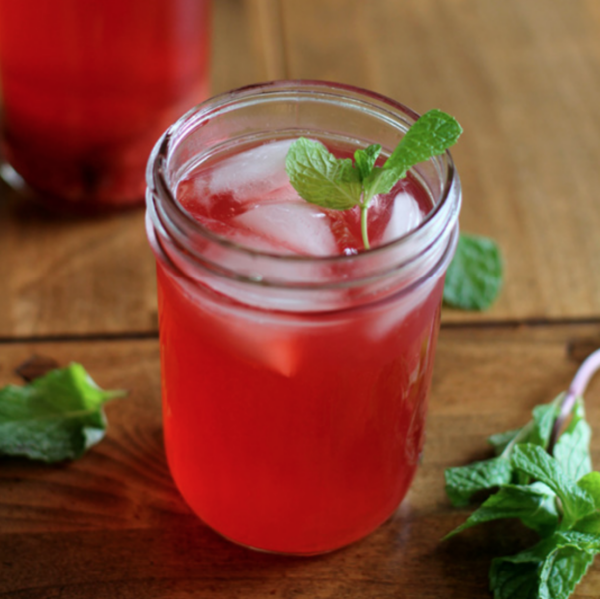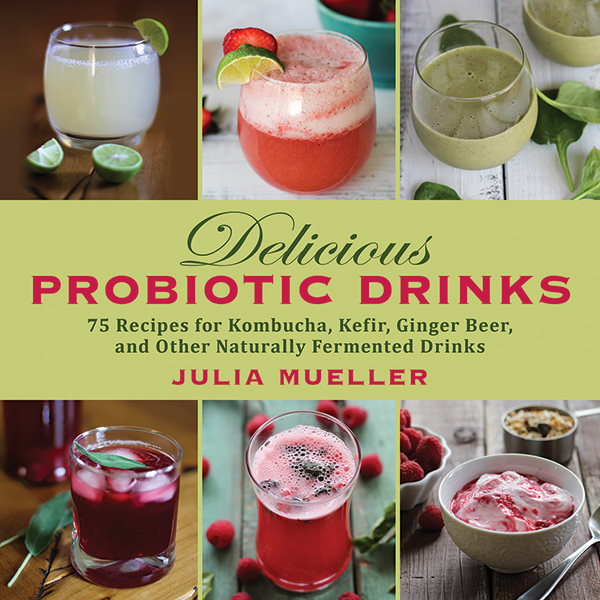


Editor’s Note:
Effervescent and salubrious, kombucha is a perfect summer thirst quencher. In “Delicious Probiotic Drinks,” Julia Mueller introduces the art of fermentation with easy-to-follow fun recipes you can brew at home. From kombucha to kefir and ginger beer—there’s a whole world of tasty fermented refreshers to be explored. The following is an excerpt about probiotics and kombucha from the book.
Probiotics are good bacteria that help promote and maintain the microflora in your digestive tract to achieve digestive balance and overall gut health. There are thousands of strains of helpful bacteria and yeast; the type of bacteria touted as being the most beneficial to our digestive systems is Lactobacillius, which is the live culture present in yogurt, kombucha, kefir, ginger beer, etc. While you can purchase a large array of probiotic supplements and drinks from the grocery store, they tend to be pricy and are not always as effective as those made at home.
In the battle of good and evil bacteria, probiotics are the good guys. Probiotics help fight off harmful bacteria, which can prevent or heal sickness, boost immunity, and increase energy. Some companies even manufacture probiotic cleaners for use in your home or commercially to keep a sanitary environment.
On a daily basis, we consume foods lacking in live nutrients. The root of this issue is twofold, beginning with the way our food is sourced and ultimately how our food is prepared. Our meats are often filled with antibiotics and our fresh produce can be genetically modified and sprayed with chemicals. We rely heavily on cooked foods, such as breads and pastas. Because of the convenience of commodity foods, we forget that optimal nutrition comes from a diet rich in raw, whole foods.
While adding probiotic drinks to your diet will not necessarily provide a cure-all for any nutrition deficits, it certainly will help heal your gut from damage that difficult-to-digest foods (such as wheat, beans, legumes, processed sugars) have caused. It will also help establish a positive environment for the existing beneficial microorganisms in your gut to flourish, assisting in the breakdown of food, fighting off pathogens, and boosting your immune system.
Each probiotic drink has its own unique strains of bacteria and/or yeasts. There are thousands of strains of helpful bacteria and yeasts, each providing a supportive role in our digestive and immune systems. The health benefits of probiotic drinks are extensive.
Probiotic drinks promote efficient digestion by achieving healthy gut flora, fighting pathogens (thereby promoting immunity), and boosting energy levels for overall vitality. In a sense, fermented foods are “predigested,” as sugars in the food or drink have already broken down. This makes them easier to digest than non-fermented foods and creates less work for the pancreas, which is responsible for secreting digestive fluids.
While probiotic drinks have different effects on different people, studies have shown they can help alleviate the following ailments:
Fermentation is a valuable tool that has been used in various cultures around the world for thousands of years. It has been used for making beer, wine, other fermented beverages, and shelf-stable food, all of which were important to nations prior to refrigeration to ensure a stock of food and drink could be safely kept.
Fermentation is a process that occurs when a live organism grows and multiplies as it eats the food it is supplied and converts it into acid and alcohol. In the case of this cookbook, the live organisms are strains of bacteria and yeast, also known as probiotics. The “food” the probiotics eat comes in a form of sugar: cane sugar, honey, lactose from milk, or fructose from fruit.
Lactic acid, the acid that is produced during fermentation, helps achieve the proper acid balance in your stomach, either by increasing it or lowering it. Having too much or too little stomach acid can be uncomfortable and fermented foods create a balance that is favorable for proper digestion. As people age, the presence of digestive enzymes decline, which is why fermented foods and beverages are particularly useful for older folks.
Another result of fermentation is acetylcholine, which acts as a neurotransmitter in both the peripheral nervous system and the central nervous system. This neurotransmitter is responsible for many complicated functions, such as muscle contraction, maintaining healthy bowel movements, and transmitting information from one side of the brain to the other. Day to day, acetylcholine helps one achieve focus, maintains memory, and calms excitability. In this sense, acetylcholine is vital in learning and retaining information. Studies have shown those with Alzheimer’s have lower amounts of acetylcholine, which is why the disease is treated with a synthetic form of the neurotransmitter.
Similar to brewing wine and beer, the sugars present at the beginning of the fermentation are metabolized such that once your drink is brewed, there is much less sugar left than there was when you started. Also similar to wine and beer, most probiotic beverages that are water-based contain a small amount of alcohol. For this reason, it is very important to be cautious when allowing children to drink home-brewed probiotic beverages, especially when the beverages are brewed strong.
Kombucha is a naturally bubbly (or “effervescent”) probiotic drink. It originated in Northeast China then made its way to Russia. Kombucha was then brought to Germany, followed by the rest of Europe and the world. Kombucha is made from a living organism called a SCOBY, which stands for Symbiotic Culture of Bacteria and Yeast. A SCOBY is often referred to as a “mushroom” or “the mother.” It grows, multiplies, ferments, and feeds off tea and sugar. The probiotics and yeast eat the sugar, which ferments the beverage and results in a drink that is acidic, probiotic-rich, and mildly alcoholic.
Kombucha contains acetic acid, which is a mild natural antibiotic. Because of the acidity of kombucha, bad strains of bacteria cannot grow in the culture, as the environment is not optimal for survival or reproduction. In this way, the good bacteria thrive while the bad bacteria have no fighting chance. Kombucha also contains lactic acid, and is rich in B vitamins, folate, and antioxidants.
It is stated that kombucha can aid in digestion, increase energy, manage hunger, and can create pH balance in the digestive tract.
What does it mean to keep a SCOBY healthy? I will touch on this throughout the list of instructions, but essentially it means the following:
- Feeding the SCOBY a mixture of tea and sugar; 100 percent black tea works best for brewing kombucha, but you may also use 100 percent green tea. Fancy teas typically contain peels and other ingredients that are not conducive to brewing kombucha. Plain black tea works great.
- Keeping it out of the sunlight in a dark place: a closet shelf works as an excellent home for brewing kombucha or jun.
- Keeping it covered while still allowing it to breathe: a kitchen towel or cheesecloth secured by a stretchy rubber band works perfectly to keep out the bugs.
- Giving it an optimal temperature range (between 75° and 85° Fahrenheit).
- Keeping the SCOBY moist with starter liquid. I recommend maintaining at least two inches of starter liquid for every one inch of SCOBY.
If you choose to purchase your SCOBY online, make sure you begin brewing a batch as soon as you receive it, as the SCOBY will be in shock.
Refer to “Delicious Probiotic Drinks” for a detailed homemade kombucha recipe. If you have already brewed your own kombucha, try these two summery drink flavors below!
The tart and sweet blackberries give a great deal of life to the kombucha, as berries tend to make for a bubblier beverage and infuse very noticeable flavor. The sage gives the beverage a soft earthiness. Blackberries are rich in antioxidants and fiber. They aid in digestion, promote cardiovascular health, protect against cancer cells and neurological diseases, and more. Sage is an herb related to mint and is full of health benefits and medicinal uses. It is an anti-inflammatory, improves memory, can be used as an antiseptic, helps with allergic reactions and mosquito bites, and is packed with antioxidants!
Ingredients:
Instructions:
- Heat blackberries in a saucepan, covered, over medium heat. As the blackberries heat up and begin to bubble and soften, mash them with a fork.
- Once a pulpy juice forms add the sugar and sage and bring to a gentle boil.
- Reduce heat to medium-low, cover the saucepan, and allow the flavors to cook together, about 15 to 20 minutes. Do not allow mixture to boil or cook for too long, or else it will become very thick.
- Leave bottles in a warm, dark place for two to four days to allow kombucha to go through secondary fermentation.
- In a large pot or pitcher, combine the kombucha and blackberry sage mixture. Mix together well and then pour the blackberry sage kombucha into sealable bottles, including the sage leaves and blackberry pulp. Seal the bottles.
- Allow the kombucha to go through its secondary fermentation by allowing it to sit in a warm, dark place for two to three days. Note that the longer the kombucha sits, the more sugar will be eaten by the probiotics, which will result in a less sweet and more fizzy beverage.
- Refrigerate for 24 hours after the secondary fermentation is complete. This slows the secondary fermentation, but the kombucha will continue to ferment and get fizzier the longer it sits in the refrigerator.
- When you’re ready to drink the kombucha, use a small fine strainer to strain out the sage leaves, blackberry pulp, and whatever small SCOBY has formed during the secondary fermentation. Discard all the pulp and enjoy the beverage!
The combination of raspberries and mint make a sweet, slightly tart, and refreshing beverage with an abundance of flavor. Fresh raspberries are heated with mint leaves to allow all the flavors to open up and infuse. Raspberry mint kombucha is a fun beverage any time of year, and is particularly great in the summer when raspberries are in season.
Ingredients:
Instructions:
- Remove mint leaves from the stems and using your fingers, rip them into smaller pieces (in half or thirds is fine).
- Place raspberries, mint leaves, sugar, and water into a small saucepan and heat over medium. Bring mixture to a full boil.
- Using a fork, smash the raspberries until they lose form.
- Reduce heat to medium-low and allow the mixture to continue to boil gently for about 5 minutes to allow the mint to infuse.
- Remove from heat and allow mixture to cool to room temperature. To speed up this process, pour it into a bowl or glass and place in the refrigerator.
- In a large pitcher or jug, combine the kombucha and raspberry-mint mixture.
- Stir to combine, then pour the kombucha into bottles.
- Once you reach the bottom, spoon the raspberry and mint pulp into the bottles, trying to distribute the pulp evenly among the bottles.
- Leave the bottles in a dark, warm place for two to four days to allow the kombucha to go through secondary fermentation.
- Refrigerate at least twenty-four hours before drinking. The kombucha will get fizzier the longer you wait to drink it.
- When you’re ready to drink the kombucha, use a fine strainer to strain out the newly formed SCOBY and the raspberry and mint pulp. Enjoy!
This excerpt has been adapted from “Delicious Probiotic Drinks” by Julia Mueller. To buy this book, click here.
Julia Mueller is the author of www.theroasteroot.net, a blog about nutrient-rich recipes that are fun, tasty, and approachable. She lives, works, and ferments in Jamestown, California.
What topics would you like to read about? Please let us know at health@epochtimes.nyc



